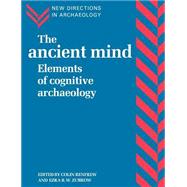
The Ancient Mind: Elements of Cognitive Archaeology
by Edited by Colin Renfrew , Ezra B. W. Zubrow-

This Item Qualifies for Free Shipping!*
*Excludes marketplace orders.
Buy New
Rent Textbook
Used Textbook
We're Sorry
Sold Out
eTextbook
We're Sorry
Not Available
How Marketplace Works:
- This item is offered by an independent seller and not shipped from our warehouse
- Item details like edition and cover design may differ from our description; see seller's comments before ordering.
- Sellers much confirm and ship within two business days; otherwise, the order will be cancelled and refunded.
- Marketplace purchases cannot be returned to eCampus.com. Contact the seller directly for inquiries; if no response within two days, contact customer service.
- Additional shipping costs apply to Marketplace purchases. Review shipping costs at checkout.
Summary
Table of Contents
| Foreword | |
| Part I. Introduction: 1. Towards a cognitive archaeology | |
| Part II. The Interdisciplinary Underpinning: 2. Interpretations and testability in theories about prehistoric thinking | |
| 3. Archaeology and cognitive science | |
| 4. From mental modularity to generalized intelligence: a cognitive interpretation of the Middle/Upper Paleolithic transition | |
| 5. Are images animated? The psychology of images in Ancient Greece | |
| Part III. Approaches to Cult Practice and Transcendental Belief Systems: 6. The archaeology of religion | |
| 7. Ancient Zapotec ritual and religion: an application of the direct historical approach | |
| 8. The meaning of death | |
| 9. Prehistoric cognition and the science of archaeology | |
| Part IV. Prehistoric Conceptions of Space and Time: 10. Symbols and signposts: understanding the prehistoric petroglyphs of the British Isles | |
| 11. Knowledge representation and archaeology: a cognitive example using GIS | |
| 12 Dials: a study in the physical representation of cognitive systems | |
| Part V. The Material Basis of Cognitive Inference: Technology: 13. Cognitive aspects of 'technique' | |
| 14. Mindful technology: unleashing the Chaî | |
| ne Opé | |
| ratoire for an archaeology of mind | |
| 15. Prehistoric technology: a cognitive science? | |
| Part VI. The Material Basis of Cognitive Inference: Writing Systems | |
| 16. Variation and change in symbol systems: case studies in Elamite Cuneiform | |
| 17. Figure and text in Mesopotamia: match and mismatch | |
| Part VII. Conclusion: 18. Cognitive archaeology reconsidered. |
An electronic version of this book is available through VitalSource.
This book is viewable on PC, Mac, iPhone, iPad, iPod Touch, and most smartphones.
By purchasing, you will be able to view this book online, as well as download it, for the chosen number of days.
Digital License
You are licensing a digital product for a set duration. Durations are set forth in the product description, with "Lifetime" typically meaning five (5) years of online access and permanent download to a supported device. All licenses are non-transferable.
More details can be found here.
A downloadable version of this book is available through the eCampus Reader or compatible Adobe readers.
Applications are available on iOS, Android, PC, Mac, and Windows Mobile platforms.
Please view the compatibility matrix prior to purchase.
